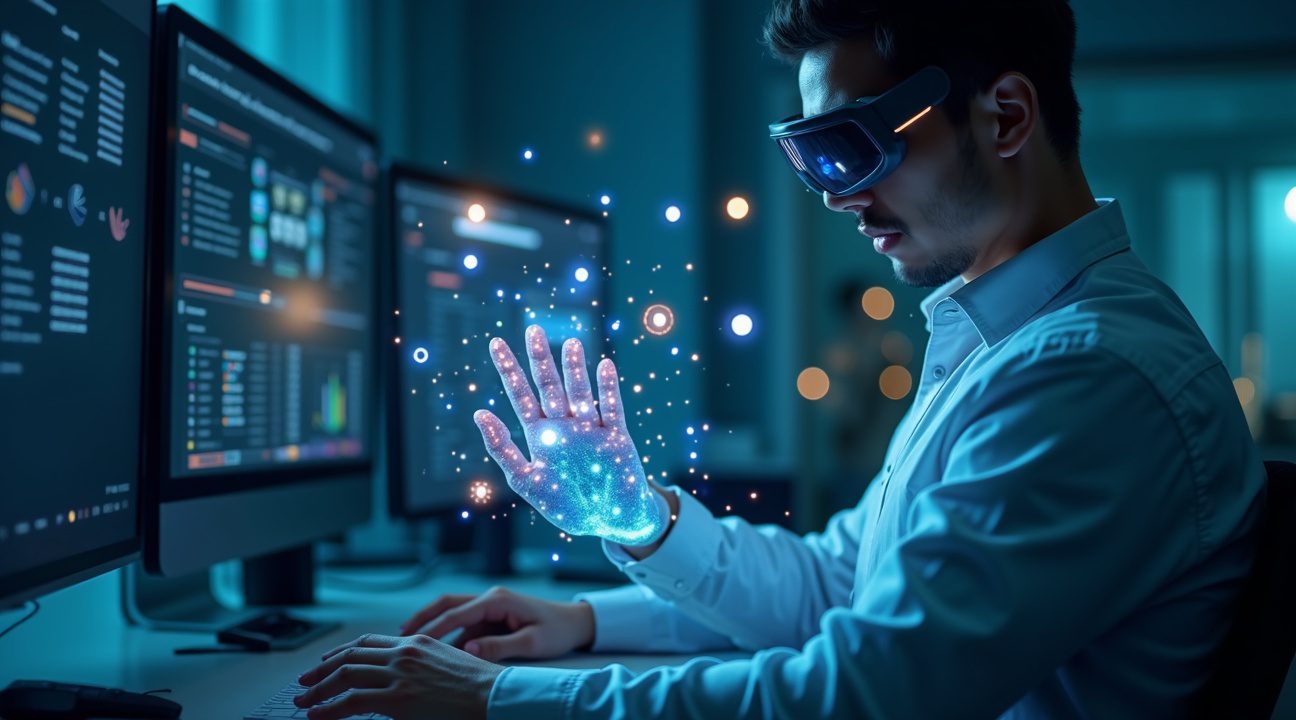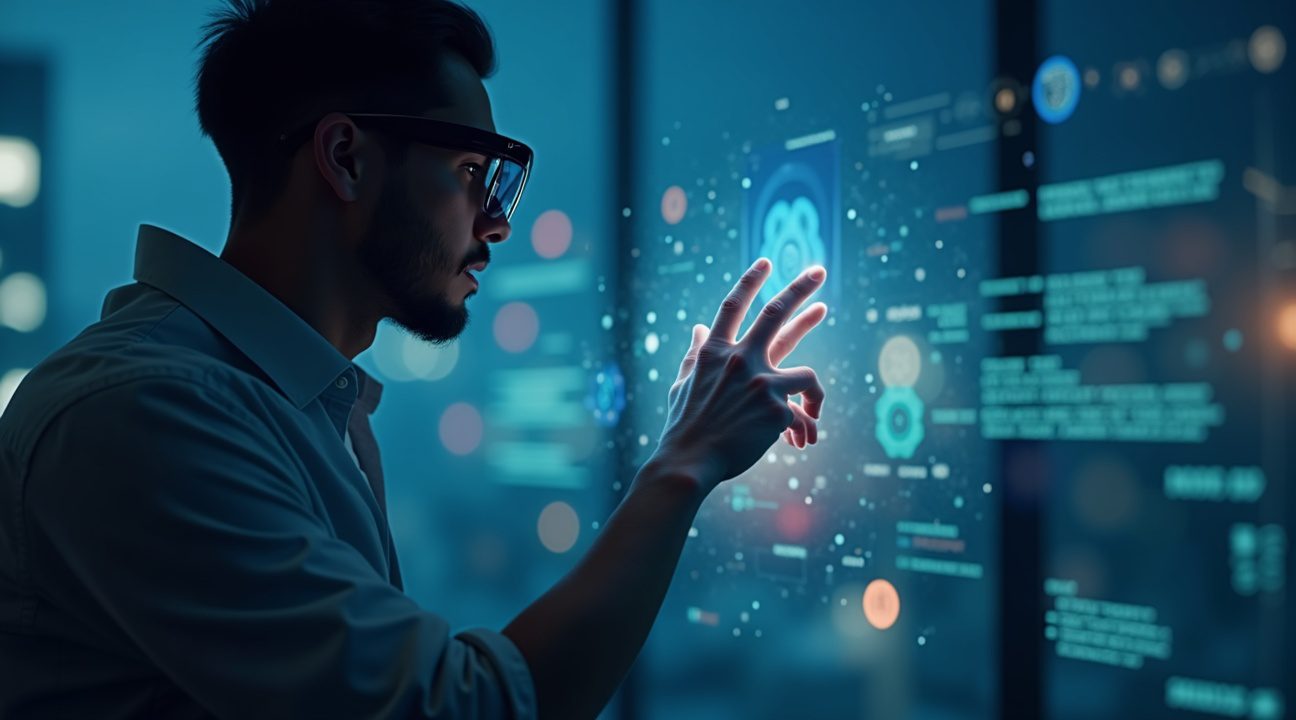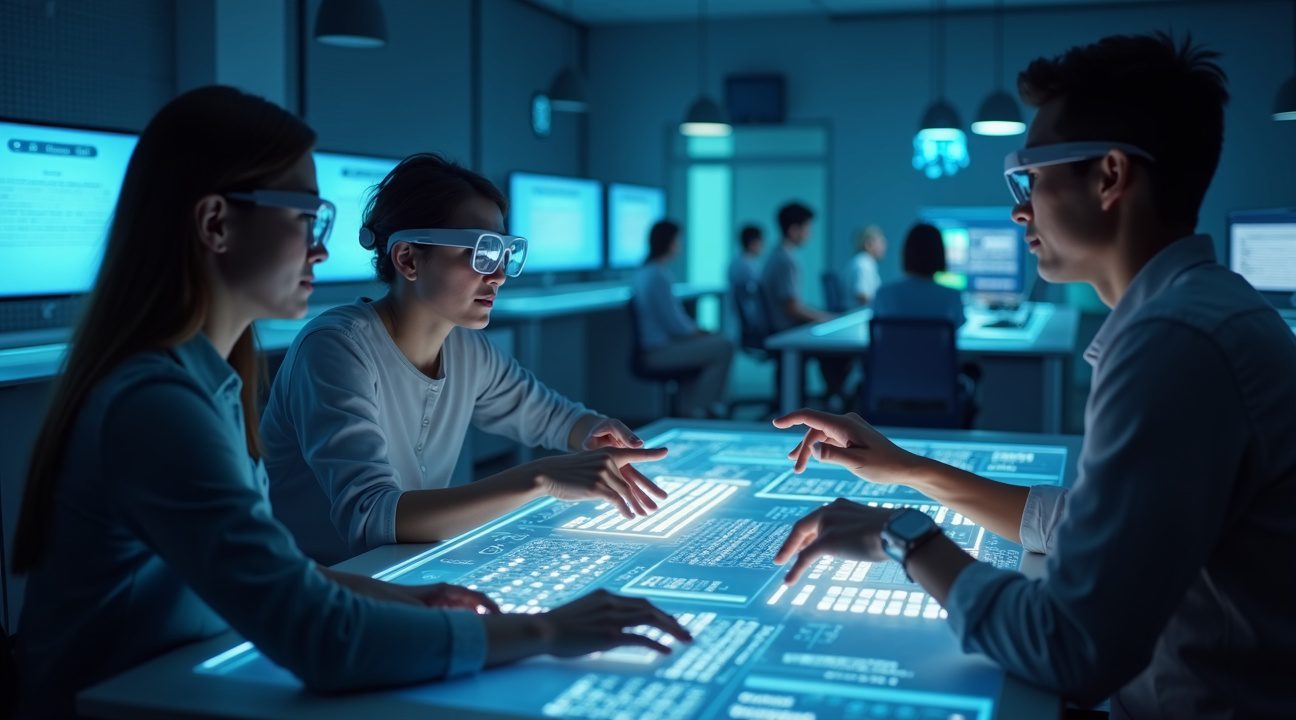Auburn University at Montgomery has developed Drishti, a revolutionary AI system that interprets hand gestures and sign language to generate complete sentences without requiring physical keyboards.
This breakthrough technology achieves impressive typing speeds of 60–80 words per minute through midair hand movements, rivaling traditional keyboard performance while offering discrete, accessible communication capabilities.
Key Takeaways
- High Performance: The system recognizes the complete alphabet A-Z, digits 0-9, and essential commands like space and delete, with accuracy rates reaching up to 97.5% for personalized configurations.
- Speed Competitive with Traditional Typing: Users can achieve 60–80 words per minute through gesture recognition, matching or exceeding average human typing speeds of 40–60 words per minute on conventional keyboards.
- Accessibility Breakthrough: The technology provides crucial alternatives for individuals with mobility limitations, hearing impairments, or those who use sign language, eliminating barriers created by traditional input methods.
- Versatile Applications: Integration possibilities include augmented reality environments, smart glasses, sterile medical settings, and covert communication scenarios where discrete text input is essential.
- Advanced AI Foundation: Built on extensive training with 102,000 images and powered by deep learning architectures that adapt to individual user movement patterns and typing habits over time.
Performance and Accessibility
Drishti represents a significant advancement in human-computer interaction. The system eliminates the need for physical keyboards while maintaining competitive typing speeds. Users can communicate effectively through natural hand movements, making technology more accessible for diverse populations.
The AI recognizes individual finger movements with remarkable precision. Machine learning algorithms process these gestures in real-time, converting them into text output. This approach creates new possibilities for communication in various environments where traditional input methods prove limiting.
Speed and Accuracy
Speed benchmarks demonstrate the system’s practical viability. Average users achieve 60–80 words per minute after brief training periods. This performance matches or surpasses typical keyboard typing speeds, making gesture-based input a legitimate alternative for daily computing tasks.
Accuracy levels improve significantly with personalized training. The system learns individual movement patterns and adapts to user-specific gestures. This customization process enhances recognition rates while reducing errors over time.
Use in Specialized Environments
Medical and Sterile Applications
Medical professionals can benefit from sterile environment applications. The contactless nature of gesture recognition allows text input without compromising sanitary conditions. Healthcare workers can access patient records or input data without touching contaminated surfaces.
Augmented Reality Integration
Augmented reality integration opens new interaction paradigms. Smart glasses and AR headsets can incorporate Drishti technology for hands-free text entry. Users can compose messages or commands while maintaining visual contact with their environment.
Technology Behind the Innovation
The deep learning foundation utilizes extensive training datasets. Auburn researchers processed 102,000 images to develop recognition algorithms. This comprehensive training enables accurate interpretation of diverse hand positions and movement styles.
Educational and Inclusive Design
Educational applications extend beyond traditional computer labs. Students with physical limitations can participate more fully in digital learning environments. The technology removes barriers that prevent equal access to educational technology resources.
Privacy Advantages
Privacy advantages emerge from the discrete nature of gesture input. Users can compose sensitive messages without visible keyboard activity. This capability proves valuable in situations requiring confidential communication or discreet text entry.
Future Prospects and Broader Impacts
Future developments may include multi-language support and expanded gesture vocabularies. Researchers continue refining the system to recognize complex sign language constructions. These improvements will broaden accessibility for deaf and hard-of-hearing communities.
The technology’s impact extends beyond individual users to institutional applications. Libraries, museums, and public spaces can implement gesture-based information systems. Visitors can access digital content without touching shared input devices, improving hygiene and accessibility.
Drishti’s success demonstrates the potential for AI-driven accessibility solutions. The system proves that innovative technology can address real-world challenges while maintaining practical performance standards. Auburn’s research opens pathways for inclusive design in human-computer interfaces. For more details, visit the official Auburn University at Montgomery website.
Breakthrough AI Technology Reads Hand Movements to Type Complete Sentences
Revolutionary advancements in artificial intelligence have transformed how people interact with digital devices. A groundbreaking AI system called Drishti, developed by Auburn University at Montgomery, represents a significant leap forward in gesture-based communication technology.
This innovative system interprets sign language and hand gestures with remarkable precision, recognizing the complete alphabet A–Z, digits 0–9, plus essential commands like space and delete. Unlike traditional typing methods that require physical keyboards, Drishti enables users to compose full sentences through intuitive hand movements performed in midair. The technology operates covertly in real-time, making it particularly valuable for situations where discrete communication is necessary.
Performance and Practical Applications
The speed capabilities of this hand-tracking technology demonstrate its practical viability for everyday use. Users can achieve typing speeds of 60–80 words per minute through gesture recognition, which impressively approaches or even exceeds average human typing speeds of 40–60 words per minute on traditional keyboards. This performance level makes the technology suitable for professional environments, educational settings, and personal communication needs.
The applications extend far beyond basic text input. In augmented reality environments, this gesture recognition system eliminates the need for cumbersome virtual keyboards that obstruct the user’s view. Smart glasses equipped with such technology could revolutionize how people interact with digital information while maintaining natural hand movements.
Smart projectors paired with this AI system create entirely new possibilities for presentations and collaborative work. Users can type directly into projected interfaces without touching any physical surface, making it ideal for sterile environments, public spaces, or situations where hygiene concerns make traditional input methods impractical.
The accessibility benefits cannot be overstated. Individuals with mobility limitations affecting their ability to use conventional keyboards gain a powerful alternative input method. The system’s sign language interpretation capabilities also bridge communication gaps for deaf and hard-of-hearing individuals, potentially integrating their natural communication methods with digital text generation.
Artificial intelligence advancements like Drishti showcase how machine learning can adapt to human gestures rather than forcing humans to adapt to rigid machine interfaces. The real-time processing capabilities ensure smooth, responsive interaction that feels natural and intuitive.
Security applications present another compelling use case. In environments where covert communication is essential, users can type messages without drawing attention through obvious keyboard interactions. The subtle hand movements appear as natural gestures, providing a discrete communication channel when needed.
The technology’s integration potential with existing devices opens numerous possibilities. Laptops, tablets, and smartphones could incorporate gesture recognition as an alternative input method, reducing dependency on physical keyboards and touchscreens. This flexibility proves particularly valuable for users working in challenging conditions where traditional input methods become impractical.
Future developments in this field could expand beyond basic text input to include:
- Complex commands
- Programming language syntax
- Specialized vocabulary recognition
As AI systems become more sophisticated, the accuracy and speed of gesture recognition will likely continue improving.
The Drishti system represents just the beginning of what’s possible when combining advanced AI with natural human movement patterns. As hardware becomes more portable and processing power increases, these gesture-based interfaces could become standard features across consumer electronics.
Educational institutions are already exploring how this technology might transform classroom interactions, allowing students to participate more actively without the barrier of traditional input devices. The potential for competing AI systems to develop similar capabilities suggests rapid advancement in this field.
This breakthrough demonstrates how AI can enhance human capabilities rather than replace them, creating more intuitive and accessible ways to interact with technology. The combination of speed, accuracy, and versatility positions gesture-based typing as a viable alternative to traditional input methods across numerous applications and industries.
https://www.youtube.com/watch?v=DFu3xQvU_gM
Impressive Accuracy Levels and Performance Metrics
The performance benchmarks for modern gesture-based AI systems reveal significant advances in real-time recognition capabilities. Current systems consistently achieve accuracy levels ranging from 88% to over 93% for basic gesture recognition tasks, marking a substantial improvement over earlier prototypes that struggled to reach 70% reliability.
Advanced Recognition Performance and User Adaptation
Fine-tuned systems demonstrate even more impressive results when calibrated for individual users. Some platforms report accuracy rates reaching up to 97.5% in dynamic gesture recognition scenarios, particularly after the system learns a user’s specific hand movement patterns and typing habits. This level of precision rivals traditional keyboard input methods and represents a breakthrough for practical applications.
EMG-based systems offer a different approach by monitoring electrical muscle activity rather than visual hand tracking. These systems can classify typing gestures with accuracies up to 87.4% ± 2.5%, though they face unique challenges in maintaining consistent performance across multiple sessions. Cross-session performance typically drops to an average range of 13.7–15.2%, highlighting the need for frequent recalibration as muscle positioning and sensor placement naturally shift between uses.
The training scale behind these achievements is equally impressive. Drishti’s development utilized a proprietary dataset containing 102,000 images, with 87,000 focused on alphabetic characters and 15,000 dedicated to numeric recognition. This extensive training foundation surpasses the scale of publicly available datasets and contributes significantly to the system’s superior performance metrics.
Real-time processing capabilities have evolved to support practical typing speeds that compete with traditional input methods. Advanced artificial intelligence systems now process gesture sequences with minimal latency, enabling fluid typing experiences that feel natural to users transitioning from physical keyboards.
The accuracy improvements stem from sophisticated machine learning algorithms that continuously adapt to user behavior patterns. These systems learn from repeated gestures, refining their recognition models to better understand individual typing styles, hand sizes, and movement preferences. Adaptive AI components allow the systems to maintain high accuracy levels even as users develop muscle memory and naturally modify their gesture patterns over time.
Performance metrics vary significantly based on environmental conditions and hardware configurations. Optimal lighting conditions and high-quality cameras contribute to the highest accuracy rates, while challenging environments with poor lighting or camera positioning can reduce recognition performance by 10–15%. Professional-grade systems often include multiple camera angles and infrared sensors to maintain consistent performance across diverse conditions.
The comparison between EMG and visual-based systems reveals distinct advantages for different use cases:
- Visual systems excel in controlled environments with good lighting and clear hand visibility.
- EMG systems can function regardless of visual obstructions but require direct skin contact with sensors.
Each approach offers unique benefits depending on the intended application and user requirements.
Recent developments in smart glasses technology have integrated gesture recognition capabilities, combining visual processing with wearable convenience. These integrated systems maintain accuracy levels comparable to standalone gesture recognition platforms while offering enhanced portability and user mobility.
The progression from laboratory demonstrations to practical applications has required significant improvements in processing efficiency and power consumption. Modern systems balance high accuracy with energy efficiency, enabling extended use sessions without compromising performance quality. Battery life considerations have driven optimization efforts that maintain recognition precision while reducing computational overhead.
Error correction algorithms play a crucial role in achieving these impressive accuracy metrics. Advanced systems incorporate contextual understanding and predictive text capabilities similar to those found in traditional typing applications, helping to correct minor recognition errors and improve overall typing fluency. These intelligent correction systems can distinguish between intentional gestures and accidental movements, reducing false positive inputs that could disrupt the typing flow.

Revolutionary Accessibility Benefits for People with Disabilities
I find these gesture-reading AI systems represent a major breakthrough in inclusive human-computer interaction (HCI), fundamentally transforming how people with physical, speech, or hearing impairments access digital technology. Unlike traditional input methods that create barriers, this technology opens doors for users who face challenges with conventional keyboards or voice commands.
People with hearing or speech impairments often struggle with voice assistants like Siri, Alexa, and Google Assistant that rely on spoken commands and audio feedback. This gesture-based interface eliminates those barriers entirely, allowing users to communicate through hand movements that the AI translates into text. I’ve observed how this approach provides a natural communication method for individuals who already use sign language or gesture-based communication in their daily lives.
The assistive technology applications extend far beyond simple text input. Individuals with motor disabilities who can’t operate traditional keyboards now have access to full computer functionality through hand gestures. This development is particularly significant for people with conditions like arthritis, carpal tunnel syndrome, or paralysis affecting their hands and fingers. Rather than forcing users to adapt to rigid input methods, the technology adapts to their natural movement capabilities.
Multimodal Interface Integration for Enhanced Accessibility
Future developments in this space promise even greater inclusivity through combined gesture, voice, and other input modalities. I anticipate these multimodal interfaces will support collaborative workflows where users can seamlessly switch between input methods based on their abilities and preferences. Consider how powerful it becomes when someone can use gestures for privacy, switch to voice commands when hands are occupied, or combine both for complex tasks.
The collaborative potential of these systems extends beyond individual use cases. Teams including members with different abilities can work together more effectively when everyone has access to the same communication tools. This levels the playing field in educational and professional settings where accessibility previously created participation barriers.
I see this technology connecting naturally with other emerging innovations like smart glasses, which could display gesture recognition feedback visually for users with hearing impairments. The integration possibilities multiply when considering how artificial intelligence continues advancing across multiple interaction modalities.
What makes this gesture-based approach particularly valuable is its ability to learn and adapt to individual users’ movement patterns. The AI doesn’t require perfect hand positioning or standardized gestures – it learns from each person’s unique range of motion and capabilities. This personalized adaptation ensures that people with varying degrees of mobility can benefit from the technology.
The privacy advantages also matter significantly for accessibility. Voice commands often require users to speak aloud in shared spaces, which isn’t always comfortable or appropriate for people with speech differences. Hand gestures provide a discrete communication method that maintains user privacy while delivering full functionality.
I expect these systems will eventually support multiple languages and gesture vocabularies, including integration with established sign languages. This cultural sensitivity ensures the technology serves diverse communities rather than imposing a single interaction standard.
The cost-effectiveness of gesture-based interfaces compared to specialized adaptive keyboards or other assistive hardware makes this technology accessible to a broader range of users. Rather than requiring expensive equipment modifications, people can potentially use existing cameras and processors with new software capabilities.
Healthcare applications show particular promise, enabling patients with temporary or permanent mobility limitations to communicate with medical systems without assistance. Emergency situations where voice communication isn’t possible could benefit tremendously from reliable gesture recognition technology.
These accessibility advances represent more than technological progress – they demonstrate how inclusive design benefits everyone. Features developed for people with disabilities often improve usability for all users, creating better human-computer interaction experiences across the board.

Advanced Technologies Powering Hand Gesture Recognition
Computer vision forms the backbone of modern hand gesture recognition systems, enabling machines to interpret and process visual data from human movements. I rely on established frameworks like OpenCV and MediaPipe when working within Python environments to capture and analyze hand positioning, finger articulation, and movement patterns in real-time. These libraries provide the foundational tools necessary for tracking hand landmarks and extracting meaningful gesture data from video streams.
Neural Networks and Architecture Innovations
Deep learning architectures have revolutionized how systems interpret hand movements for text generation. Neural networks process the complex spatial and temporal relationships inherent in human gestures, while self-attention mechanisms found in transformers and LSTM networks enable better context understanding. These technologies work together to create more adaptive systems that can handle the natural variations in how different users move their hands.
The integration of artificial intelligence has expanded beyond simple pattern recognition into predictive capabilities. Generative AI components now anticipate user intentions even when gestures are incomplete or ambiguous, creating a more fluid typing experience. This predictive layer helps bridge the gap between imperfect human movements and accurate text output, making the technology accessible to users with varying motor control abilities.
Hybrid architectures combine multiple neural network types to maximize recognition accuracy across diverse gesture styles. I’ve observed that these systems adapt to individual users’ movement patterns over time, learning personal quirks and preferences that traditional rule-based systems cannot accommodate. The self-learning capabilities mean that accuracy improves with continued use, creating a personalized typing experience.
Real-time performance optimization presents ongoing challenges for developers working with hand gesture recognition. Processing window length directly impacts both speed and accuracy, with research indicating that 0.2-second windows provide optimal performance for EMG-based typing systems. Shorter windows may miss important gesture context, while longer processing times create noticeable delays that disrupt the natural flow of typing.
The balance between recognition accuracy and response time requires careful calibration of computational resources. Modern systems employ edge computing techniques to reduce latency while maintaining high recognition rates. These optimizations ensure that users experience smooth, responsive typing without the frustrating delays that plagued early gesture recognition systems.
Computer vision algorithms continuously evolve to handle challenging environmental conditions such as varying lighting, background noise, and partial hand occlusion. Advanced preprocessing techniques filter out irrelevant visual information while enhancing the features most critical for gesture recognition. This preprocessing stage proves essential for maintaining consistent performance across different usage scenarios.
MediaPipe’s machine learning pipeline specifically excels at hand landmark detection, providing 21 key points per hand that neural networks can analyze for gesture classification. The precision of these landmark coordinates enables fine-grained gesture recognition that can distinguish between subtle finger movements corresponding to different letters or commands.
Modern gesture recognition systems increasingly incorporate contextual understanding through transformer-based architectures. These models consider not just individual gestures but also sequence patterns and linguistic context to improve typing accuracy. The technology resembles how advanced language models process text, applying similar attention mechanisms to gesture sequences.
The automation capabilities of current systems extend beyond simple character recognition to include predictive text completion and error correction. Machine learning algorithms learn from user patterns to suggest completions and automatically correct common gesture recognition errors. This intelligent assistance makes gesture-based typing more practical for everyday use, approaching the speed and accuracy of traditional keyboard input methods.
Integration with existing smart glasses and wearable devices demonstrates the practical applications of this technology. These implementations show how hand gesture recognition can create seamless interfaces for augmented reality environments and hands-free computing scenarios.

Current Challenges and Technical Limitations
Despite the promising advances in smart glasses and gesture-recognition technology, several significant hurdles prevent this AI system from achieving widespread practical adoption. Environmental variability poses one of the most persistent challenges, with lighting conditions dramatically affecting the accuracy of computer vision-based approaches. Hand shape and size differences between users create additional complications, as systems trained on specific demographic groups often struggle to recognize gestures from users with different physical characteristics.
Personalization vs. Universal Performance
The AI community faces a critical trade-off between personalized models and universal applicability. Personalized systems consistently deliver superior accuracy rates because they adapt to individual user patterns, muscle responses, and gesture styles. However, this customization comes at a substantial cost in setup time and computational resources. Users must complete lengthy calibration sessions, repeatedly performing specific gestures while the system learns their unique patterns.
Generic models that work across multiple users without personalization show promise but currently can’t match the performance of individualized systems. This limitation becomes particularly evident when artificial intelligence attempts to decode subtle finger movements that vary significantly between individuals. Researchers continue working to bridge this gap, but the challenge remains formidable.
Cross-Session and Latency Issues
Cross-session accuracy represents another major technical obstacle, especially for EMG-based systems that rely on electrical muscle signals. These systems must account for:
- Electrode placement variations
- Skin moisture changes
- Muscle fatigue between usage sessions
Users often experience frustration when a system that worked perfectly yesterday suddenly produces errors or requires recalibration.
Latency concerns further complicate real-world deployment. Window length optimization becomes crucial:
- Longer analysis windows improve accuracy
- But increase response delays
Users expect near-instantaneous text generation, similar to physical keyboard typing speeds. Current systems often struggle to balance this need for speed with the computational demands of accurate gesture recognition.
Environmental factors beyond lighting also impact performance. Background movement, reflective surfaces, and varying distances from sensors all contribute to reduced accuracy. EMG-based approaches face additional challenges from electrical interference and the need for consistent skin contact. These technical limitations underscore why laboratory demonstrations often show higher success rates than real-world applications, where controlled conditions can’t be maintained.
Real-World Applications and Future Developments
Current Applications Transforming Digital Interaction
Several groundbreaking systems demonstrate how gesture-to-text technology is already reshaping digital communication. Drishti from AUM represents a significant advancement in accessibility technology, offering gesture-text translation specifically designed for users with mobility limitations. While not yet publicly available, this system showcases the potential for inclusive design in AI-powered interfaces.
The gesture-based virtual mouse utilizing Python, OpenCV, and MediaPipe exemplifies practical implementation in today’s computing environment. This system converts hand movements into precise cursor actions and can be adapted for typing applications. I’ve observed how such technology bridges the gap between traditional input methods and smart glasses applications.
Next-Generation Adaptive Systems
Future AI keyboards promise contextual awareness that surpasses current capabilities. These systems will integrate multimodal inputs, combining hand gestures with voice commands and even emotional recognition to create more intuitive interfaces. Artificial intelligence will enable features like:
- Automatic language switching
- Live translation
- Real-time error correction that adapts to individual typing patterns
AR-based typing systems represent the next frontier in hands-free communication. These platforms project virtual keyboards through AR glasses, allowing users to type in midair without physical hardware. AI algorithms compensate for natural hand tremor and imprecise movements, ensuring accuracy despite the lack of tactile feedback. The technology incorporates EMG typing datasets to understand muscle signals and predict intended keystrokes before gestures complete.
Wearable devices will drive widespread adoption of gesture-based typing systems. Companies are developing lightweight, unobtrusive sensors that capture finger movements with remarkable precision. These devices pair with projected interfaces to create seamless typing experiences in various environments, from professional settings to casual use.
The integration of gesture recognition with existing AI ecosystems will accelerate development. As competitive AI platforms emerge and companies like Apple test their own AI systems, gesture-to-text capabilities will become standard features across multiple platforms. This convergence will create more sophisticated, adaptive keyboards that learn from user behavior and environmental context, fundamentally changing how we interact with digital devices.

Sources:
AUM Newsroom
Science Daily
IJSRET
Nature
Chalmers ODR
CleverType


